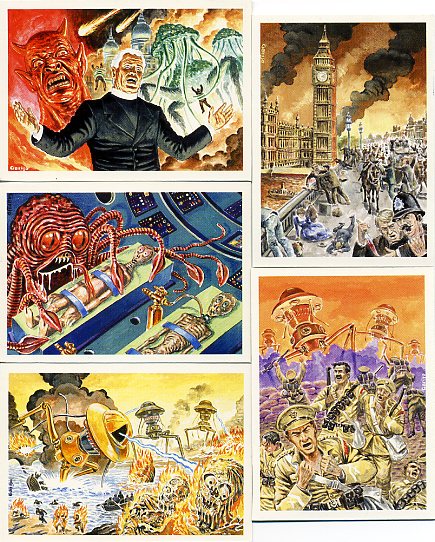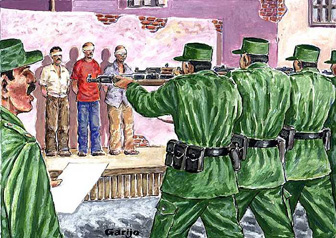Ricardo Garijo: 1953 - 2009
By Kurt Kuersteiner © 2009
It is with great sadness that I inform trading card fans that Ricardo Garijo died October 3, 2009. He had been battling cancer for two years and was 55 when he finally succumbed to the disease. Ricardo was a remarkable artist, a devoted father of three, and a loving husband. He had also become a close personal friend during the six years that he painted for Monsterwax.
I met Ricardo back in 2003 through email when he sold me his childhood collection of Spanish Mars Attacks. He knew I also made card sets and asked if I would consider using him as an artist. To be polite, I agreed to review his work, and to my surprise, I was blown away with the quality. We began to collaborate together over the web with me in Tallahassee Florida, and him in Buenos Aires, Argentina.
The first series he painted for Monsterwax was Don't Let It Happen Here . We had a great time devising the series together and he was incredibly fast as well as detailed. Ricardo mentioned that he was a big fan of science fiction. When I told him I was interested in doing a card set based on H.G.Wells, he wanted to paint that as well. That project evolved into three series: The Time Machine, Island of Dr. Moreau, and War of the Worlds.
Although American fans became best acquainted with his work through these various card sets, it was actually his comic book art that made him well known in Argentina and Europe.
The following highlights of his career are based on the biographical details provided by English writer and comic collector, Steve Holland:
Ricardo was born in Tandil in Argentina's Buenos Aires Province on Dec. 1 st , 1953. His parents were Spaniards. His mother was active in the French Resistance, and his father spent much of the war imprisoned in Mauthausen and Gusen labor camps. (Ricardo still owned his father's prison jacket.) When he was born, he was swaddled in material made from British military parachutes.

Garijo began scripting and drawing science fiction strips for daily newspapers at age 23: "Planeta de Acero" [Steel Planet] for La Capital , published in Mar del Plata (1979-80) and "Lomax--Un Viaje al Espacio Profundo" for La Razon , published in Buenos Aires (1981-82).
He worked for Scottish publisher D. C. Thomson for nearly two and a half decades. His earliest known strip was the Alan Hemus-penned "Blue Hawk One" in Champ in 1985, about a futuristic intelligent helicopter and its pilot. Hemus was also a leading writer for Starblazer and the two were re-teamed for a series of comedy buddy-cop stories featuring the mismatched Grok and Zero, which ran for six episodes (1986-90). Discovering that Garijo had a talent for comedy, he was also assigned to draw The Robot Kid series (1987-90) written by Mike Chinn, in which a robotic cinema usher, programmed with every movie cliché possible, is sent to protect a frontier planet from attack. Over the course of three stories, the series parodied the Sergio Leone Western, Martial Arts movies and Rambo-esque actioners.

When Starblazer came to an end, Garijo switched to war stories for Commando , beginning with "Another Tight Spot" (#2469, May 1991) and averaging an issue every two months. In all he produced about 90 issues, the latest, "Need to Know" (#4236), on the shelves at the time of his death.
* * * * *
That's right--90 issues of comics, nearly one every other month. No wonder he was so fast painting cards. He was well rehearsed! And remember, the above are only the highlights.
Ricardo was an avid fan of other comic writers and artists. It was his enthusiasm that turned me on to the comics of Hector Oesterheld (his favorite writer), and he urged me to do an article about the famous Argentine comics pioneer (see The Wrapper #213). Ricardo also painstakingly translated the Argentine version of Mars Attacks from Spanish to English, which revealed a very different (and often amusing) text when compared to its American counterpart. In short, he was a great ambassador for not only comic art, but also Argentine pop culture.

Ricardo was good enough at English to convey a great sense of humor. (He had learned it watching American movies and listening to Beatle's records!) His emails were often very witty and always upbeat. I only spoke to him a couple of times on the phone (due to long distance and time zone complications) but both occasions were great events for me. We wanted to meet sometime in person, but travel to the USA became difficult after 9/11, and I never made it down to South America.
He told me about his charming wife, Adriana (who is a teacher), and his three children (now full grown adults). He explained the history of his country, and the "dirty war" that killed between ten and thirty thousand subversives before military rule ended in 1983 after the British won the Falkland Island war. We compared notes about our countries and customs, the political intrigues, and other similarities and differences. We also talked about the friends and family we cared about. Above all, we discussed the fun of creating stories and art to illustrate them. You see, Ricardo wasn't just a painter, he was also a writer, and he wrote an award winning novel, El Fuego [The Fire], as well as a prize-winning short story, Los Trenes [The Station]. In fact, he just recently finished a novel about his father's imprisonment in a German concentration camp, El Cielo de Piedra [The Stone Sky]. This novel also contains several pieces of his art, and will be published soon.
Ricardo suffered from a brain tumor, the same thing that killed my brother a decade earlier. He went through a similar process as well. The tumor made him forget things (including his English), and he worried he was literally losing his mind. He went to the hospital and they discovered and removed the cancer, then used aggressive radiation to try to stop it from returning. It worked for about a year, and he returned to his old self. During that time, he visited with old friends, traveled to see his son in Spain, and worked on more art projects. We all hoped he had beaten the threat. But unfortunately, the tumor returned a year or so later, and this time, it couldn't be stopped.
To say that Ricardo had a big influence on Monsterwax would be an understatement. He made it possible for us to produce many original art non-sports cards at a time when no one else would. After he did such a fantastic job on the H.G. Wells cards, I asked him what he recommended we work on next. He said his favorite author growing up was Jules Verne, and he'd love to paint some Verne stories. So that's exactly what we set out to do. He began to paint Journey to the Center of the Earth, and 20,000 Leagues Under the Sea. Unfortunately, that's when he first became sick and had to discontinue. He reluctantly relinquished the assignment and told me he didn't think he would be able to finish it. I told him not to worry about that and to concentrate on getting well. About six months later, he had recovered from the first operation and wanted to start again. Remarkably, he hadn't lost any of his talent and he enthusiastically finished both sets. Soon afterwards, he notified me that the cancer had returned and his medical battle had resumed. It was devastating news, but he was very brave about it. He had finished his novel, visited many of his friends and family, and completed his pet card project. There was still much he wanted to do, but I think he was grateful he had received extra time in that final year to do some of the things that were important to him, especially in regards to seeing family and friends.
Above: Spanish Documentary on Garijo (12 min)
It is impossible not to mourn the passing of a good friend, but I think Ricardo himself would want his friends and fans not to dwell on his own loss of life, but rather, to celebrate the real and imagined lives he created through his paintings, stories, and his precious family.
Although he didn't live to see his last novel or final card series published, both should be released in 2010. I know it was important to him to finish writing his father's book, and it also seems fitting that his favorite boyhood book should be the last series he painted for his trading card fans. We will remember and miss this great storyteller.



